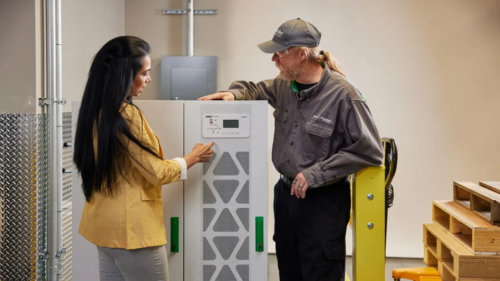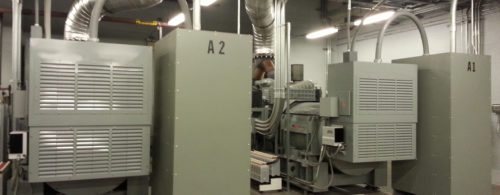Mentoring control engineers and technicians
I always open my classes with this question: How many of you are doing today what you went to school to learn to do? It's not unusual for less than half the class to raise their hands in response.
View the full story , including all images and figures, in our monthly digital edition .
I always open my classes with this question: How many of you are doing today what you went to school to learn to do?
It’s not unusual for less than half the class to raise their hands in response. I ask this question for a number of reasons. For one thing, it’s an icebreaker. I’m not doing what I went to school to learn; by degree and training, I’m a licensed airframe and power plant mechanic and an aircraft maintenance engineer. Yet, here I sit writing an article on mentoring control engineers and technicians.
But, the fact that many people in this industry learned a lot of what we know on the job is a strong statement about the power of mentoring. There is no way that I could do what I do without the many people who generously shared their knowledge and time. In discussing mentoring, my aim is to convey not only the technical lessons I learned but also the mentoring technique by which I learned them.
Early experiences: the mentoring sessions
My first mentoring experiences related to control systems occurred in my first week on the job. Chuck McClure, founder of McClure Engineering, assigned me the task of making a system diagram for a chilled-hot water system renovation project that was currently under construction.
After looking over the drawings for a while, I found a little schematic the designer put on the drawings showing the pumps and other equipment in the system (see Figure 1).
Thinking I had already accomplished my task, I went to Chuck’s office and reported that we were in luck. Someone had already done a system diagram, and I showed him the schematic. It turned out that the diagram was only the starting point and not what Chuck was looking for.
Chuck stopped what he was doing and gave me a bit more direction. He wanted me to untangle the piping schematic until it “looked like a ladder on its side,” showing all of the critical loads in the order they were connected and anything that could change the direction or magnitude of flow in the system. Then, he wanted me to go into the field to verify it. The result was more along the lines of what is shown in Figure 2.
Chuck’s guidance gave me a new quest, which quickly led to two more control mentoring experiences. One was from Jim Brooks, who patiently answered a very fundamental question about one of the components of the system: “What’s a steam converter?”
Rather than shake his head and wonder what Chuck had gotten the company into by hiring me, Jim pulled out his ASHRAE Equipment Handbook and showed me the chapter on heat exchangers.
Jim then spent a few minutes talking to me about the various kinds, what you might think about if you were working with one that used steam, and some of the O&M issues that needed to be considered. This was key, considering I was hired to help develop preventive maintenance programs for building systems. (Who better to do that than an airplane mechanic, right?) Jim also made sure I knew where his ASHRAE guides were shelved. He let me know I could borrow them any time.
Later, I developed my first draft of the diagram, but I remained puzzled about how the system it represented was supposed to work. I approached Phil Sutherlin, a new addition to the project, with my questions. The system had a three-way valve on one side of the chiller, which served two functions. One was to blend hot and chilled water during the changeover from cooling to heating mode; the second was to isolate the chiller from the system when the boiler was functioning. I could see how the changeover process worked, but I kept thinking there should be an isolation valve on both sides of the chiller to isolate it from the boiler. Ah-ha! I thought I had found a problem.
“That’s a good question,” Phil said as he launched into a very practical explanation of the application of the conservation of mass principle in a working HVAC system.
Specifically, if water could not flow from the hot water system into the chiller loop on one side of the chiller, which is what the three-way valve would prevent in its full stroke position, then water would not flow from the hot water system into the chilled water system from the other side of the chiller where there was no automatic isolation valve, and, as I could now see after the explanation, no need for one.
Al Black, another mentor, put it this way on a different occasion, “The ‘goesintas’ gotta equal the ‘goesoutas.’” In other words, conservation of mass dictated that if no mass moved into the system, no mass would move out of it.
Phil also mentioned a good preventive maintenance check would be some sort of test to verify the control interlocks that commanded the valve to the position that isolated the chiller from the hot water system when the system was in heating mode. He also pointed out another important test with energy-efficiency implications. Specifically, a test to verify that the three-way valve was not leaking and that the heat exchanger was shut down when the chiller was in operation would ensure that simultaneous heating and cooling were not occurring.
Of course, if everything was working properly, the design of the control system would prevent this problem. But, having been a practicing airframe and power plant mechanic, I knew that wear and tear could take its toll on the intent behind a design, thus the need for maintenance in general, and preventive maintenance in particular. Phil left it to me to work out the tests but made sure I felt comfortable visiting his office anytime if I had questions.
Phil also took me on-site later in the week as he started the balancing process. Once we were there, he helped me start to correlate the diagram I had developed from the drawings with the actual components in the field, and introduced me to pump tests and pump curves. Phil also introduced me to Ben, a control technician who worked for the control company. Phil knew I would need to understand how the control system worked if I was going to write the manuals, tests, and checklists for the preventive maintenance program. He was right; Ben was invaluable.
Ben allowed me to “assist” him as he checked out the controls, which was my first exposure to electronic control systems. I use “assist” lightly because I suspect it took Ben about twice as long to do his job that day because I tagged along asking question after question about how things worked and what he was doing. There were occasional grumbles from Ben, but he always gave me at least a cursory answer. These answers gave me leads on where to go next to understand things and do my job.
Early experiences: the lessons
In those first few experiences on the job, I learned a number of important lessons. The technical lessons were immediately obvious.
A steam converter is a steam heat exchanger. (In my defense, I should point out that I did know what a heat exchanger was; I just had never heard it called a converter.)
Developing a system diagram is a great way to learn and verify the system. Carefully tracing out a pipe on the plans and then in the field with the intent of understanding what it does causes you to notice things that you simply would not have seen otherwise.
The system diagram makes it much easier to understand how the system works. Chuck’s point about untangling things was well-founded. I really could not have explained the operation of the system from the original schematic I found. But once I had my system diagram, both the way it operated and a potential problem jumped right out at me.
Understanding how the system works is the first step in understanding how it should be controlled. The control and operation of HVAC systems and the buildings they serve are inextricably intertwined. To do a good job of control, you have to understand how the system you are controlling is intended to function. This, of course, is the foundation of my conviction that a well-written narrative control sequence supplemented by a logic diagram and point list is a critical component of the design documentation for a project.
The fundamental physics learned in the classroom apply in the field. A real system sure looked different from the neat little black-and-white diagrams in the textbooks. I really did understand conservation of mass. But making the connection between the concept in a book and a real, working system was a jump for me, as I suspect it is for many. Once you’ve made that jump a couple of times, it becomes second nature. You might have to apply a theoretical principle to a practical situation a few times, however, before you have an instinctive comfort with it.
Understanding the fundamental physics behind how a system works is the foundation for understanding how the control system should work. To truly understand something, you likely will have to examine the fundamentals behind it. This is one of the most important things you can assist with as a mentor. Several times, I’ve had to tell a mentee that I would need to get back to him or her with an answer to a question. I knew I basically understood the issue, but in trying to explain it, I uncovered a few questions of my own that I needed to address to fully answer the mentee’s questions.
Understanding the fundamental physics behind how a system works provides insight into critical operating parameters and commissioning targets. I never would have been able to write the tests or system manual for the preventive maintenance program discussed above if I didn’t understand how the system worked.
The system diagram is a great way to communicate what you have learned to others, including the construction team, the control contractor, the commissioning team, and the operator. Typically, my system diagrams start as design or analysis tools, become troubleshooting tools during start-up and commissioning, and morph into training and persistence tools for ongoing operations.
Mentoring lessons
While I was a mentee I appreciated the mentoring lessons, but their significance didn’t sink in for a while—probably not until I found myself in a mentoring position. I’ve learned many lessons about being a good mentor.
Sometimes, you know what you mean, but the person you’re mentoring doesn’t. I’m sure Chuck felt he had given me sufficient direction the first time he assigned me the task of developing a system diagram. Maybe he didn’t fully appreciate my lack of familiarity with the buildings industry. Or maybe he was so comfortable with the concept that he just didn’t realize it was a totally new concept to me.
Lack of familiarity with industry nomenclature doesn’t necessarily equate to lack of familiarity with the fundamentals. The HVAC industry in general and the control business in particular are chock-full of industry-specific jargon. When you’ve been in a field for a while, its easy forget that the acronyms, terms, and technologies you deal with daily may be new to the person you are mentoring. In fact, that may be one of the reasons they consulted you. That doesn’t mean they are unfamiliar with the fundamentals behind the jargon. One of your jobs as a mentor is to help them make the connection. Jim helped me connect converters with heat transfer, and Phil helped me apply conservation of mass to reality.
There are few, if any, dumb questions asked in earnest. Both Jim and Phil must have sensed that the questions I was asking were pretty fundamental. They also must have known those questions stemmed from a sincere desire to understand something. In their responses, they both immediately made me feel comfortable and safe, and opened the door for me to ask more questions. This may be one of the most important things you can do as a mentor.
Be accessible: You can’t mentor someone if they can’t get to you, either because you are physically distant or emotionally distant—or both. This can be really tough sometimes when you are facing a hard deadline and the last thing you need is something else to do. But, one of the things I’ve learned is that a half hour of mentoring can actually save me hours of time down the road because I’ve shared my knowledge and empowered a mentee to use it.
Nudging someone in the right direction never hurts. Not only did Jim and Phil answer my questions when I asked; they helped me do my job. They did this by including information about the specific task I would be charged with in their answers, i.e., they pointed out the preventive maintenance opportunities and issues, leaving me to work out the details. In addition to helping me succeed, their guidance tied everything together and helped me see the bigger picture.
Never pass up an opportunity to take someone out in the field with you; the field is where theory meets reality. If you do nothing else for the people you mentor, share and foster a passion for the field with them by taking them out and getting their feet wet under your watchful eye. The industry desperately needs good field people.
Share your resources: An old flying adage is that a long runway behind you is of no value. The mentoring version of that might be that a book on the shelf gathering dust is not doing anyone much good either.
You will recall that Jim was quick to share and make me feel comfortable by permitting access to his ASHRAE books and other resources, as were other mentors in my career. At the same time, I appreciated the fact that it was important to them to know where their resources were when they needed them. I tried to respect that by returning resources when I was done, making copies, or simply finding out how to get my own copy. I have to admit that as a mentor, sometimes it’s hard to let one of my books wander out of the office. But, I’ve learned how to diplomatically tell the borrower about the book’s importance to me, and borrowers have never disrespected my books or other resources.
In my experience, the mentoring process is just as much about life and people as it is about technical skills and lessons. Phil always told me that no matter how much you like it, your job should never be more than 49% of your life. In other words, the rest of life—your bride or significant other, your kids, walking on the beach, and hobbies—always should have the edge. He and my other mentors lived that by example.
Truth be told, I’m not sure whether they considered mentoring to be on the 49% side or the 51% side. As I think about it now, I suspect it was on both.
In fact, it’s a pretty good analogy to end an article on mentoring control system engineers and technicians. Just as a good control system will integrate the components of the HVAC system and building it serves and help make it function as a whole, so will good mentoring integrate the technical and life issues that challenge someone growing in the industry, helping that person not only to excel at technical work but also to become a well-rounded individual and a valuable mentoring resource in his or her own time.
| Author Information |
| Sellers is senior engineer at Facility Dynamics and a member of Consulting-Specifying Engineer’s editorial advisory board. His background includes more than 30 years of experience with commissioning, design engineering, facilities engineering, mechanical and control system contracting, and project engineering in a wide array of facilities. Sellers also provides technical training, and develops technical guidelines on retrocommissioning and commissioning field techniques and engineering fundamentals in a number of venues. Read his blog, “A Field Guide for Engineers,” at |
Do you have experience and expertise with the topics mentioned in this content? You should consider contributing to our CFE Media editorial team and getting the recognition you and your company deserve. Click here to start this process.




